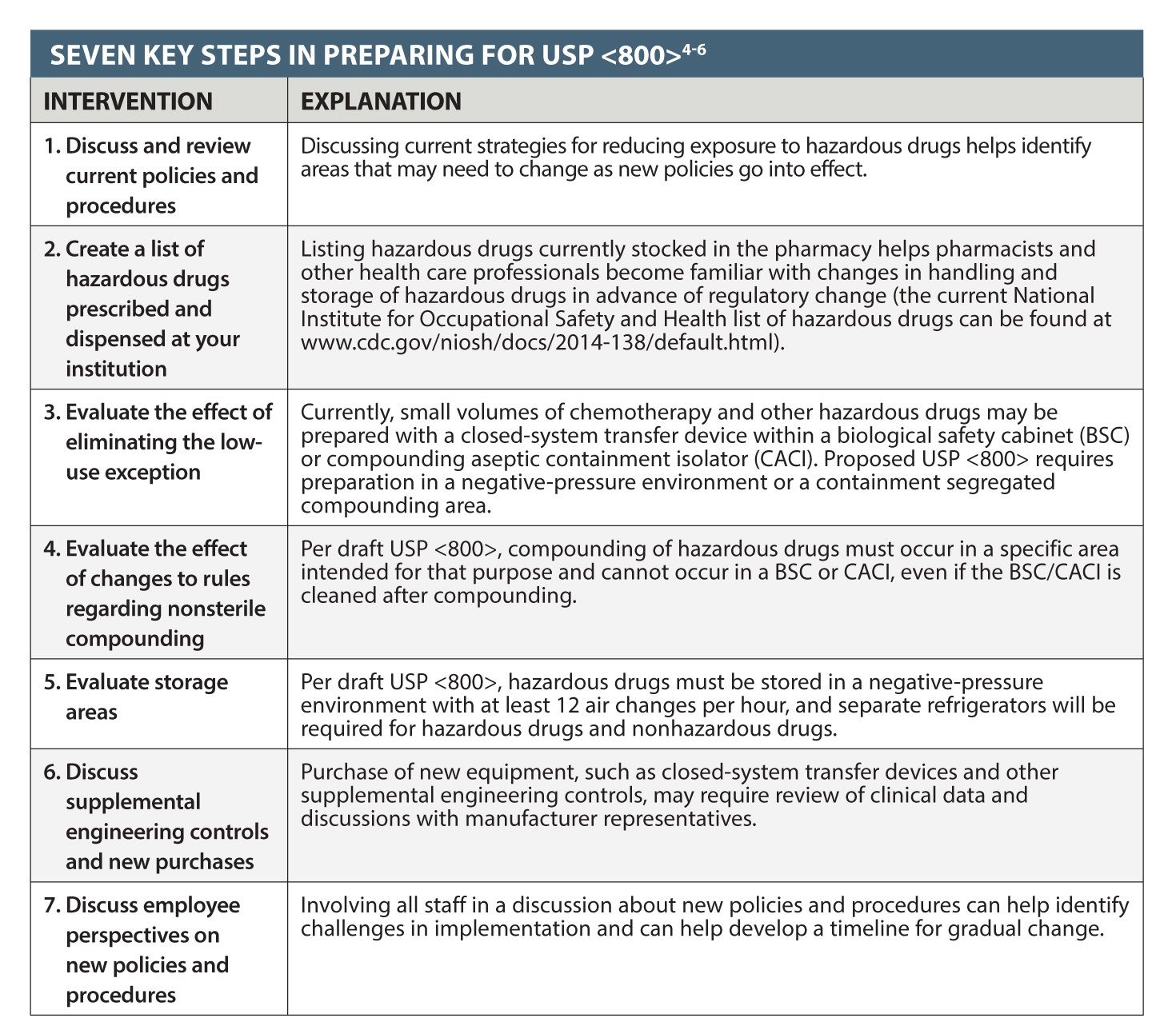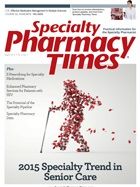Publication
Article
Specialty Pharmacy Times
Preparing for USP : The Time Is Now
Author(s):
Preparation for the implementation of USP is a multifaceted process that every pharmacy will face.
Preparation for the implementation of USP <800> is a multifaceted process that every pharmacy will face.
In recent years, several tragic and highly publicized cases have raised concerns about the handling of chemotherapy and other hazardous drugs by health care workers. For instance, pharmacist Sue Crump developed pancreatic cancer at the age of 55 years after a 23-year career in oncology pharmacy practice. Before she died, she spoke out about the safety gaps in chemotherapy handling and encouraged regulatory action to address these concerns.1-3
As a result of Sue Crump’s case and other cases, as well as abundant evidence indicating an increase in cancer risk, reproductive hazards, and genotoxicity concerns in health care professionals handling hazardous drugs, individual states have begun to institute more stringent standards regarding the storage, handling, and transport of these medications. States with legislation tightening standards of hazardous drug handling currently include Washington, Maryland, and North Carolina.3
To address these concerns in a standardized way on a nationwide scale, the United States Pharmacopeial (USP) Convention has developed a new set of regulations: proposed USP <800>. These regulations will help improve safety in the preparation, storage, and transport of hazardous medications. However, these changes will take time to gain acceptance by regulatory bodies, and stringent requirements may lead to delays in implementation.3-6
Regarding this delay in enforcement, Patricia C. Kienle, RPh, MPA, FASHP, director of accreditation and medication safety at Cardinal Health, member of the USP Compounding Expert Committee, and chair of the USP Hazardous Drug Subcommittee and Expert Panel noted, “Once published, there is a lag time before it is enforceable—6 months from the time of publication—and this may need to be a longer time period for USP <800>.”4
Because there is this major lag in enforcement, pharmacists and hospital pharmacy managers should be proactive about implementing new policies to protect health care professionals from chemotherapeutic medications and other hazardous drugs. According to Kienle, “People should not be paralyzed by [the proposed regulations of USP <800>]. Some say, ‘I’m going to wait until it’s absolutely done and then I’m going to start to react.’ These are personal safety issues that need to be addressed now.”3
Further adding to the urgency of implementing more stringent protective protocols, pharmacists and other health care professionals have reported acute side effects associated with preparing and administering hazardous substances. Many pharmacists and nurses may keep these concerns private or speak about them only with family members or personal physicians. However, as concern about the safety of current hazardous drug handling grows, more health care professionals may begin to discuss these concerns openly.
{Click image to enlarge}

In a 2004 report, the National Institute for Occupational Safety and Health reported several cases of both transient and chronic effects after possible hazardous drug exposure7:
- Two separate cases of itchy rashes in a 41-year-old patient-care assistance worker in an oncology clinic, each of which developed shortly after emptying the bedpans of 2 separate patients taking antineoplastic drugs.
- Nasal discharge, difficulty breathing, and coughing attacks occurring daily 1 to 2 hours after arriving at work in a nurse who had worked in an oncology ward for 13 years. Further examination revealed allergic asthma resulting from sensitization to several antineoplastic drugs.
- Temporary loss of skin sensation, vomiting, and abdominal cramping in a nurse with transient dermal exposure to carmustine after an accidental spill.
- Chromosomal aberrations (sister chromatid exchanges) in blood samples of individuals working in the vicinity of a malfunctioning biological safety cabinet.
In addition to the above reports, some evidence indicates that health care workers preparing, handling, and administering chemotherapy develop transient dysgeusia that may have a metallic character. These taste disturbances often occur after handling platinating chemotherapeutic drugs. Considering that more than two-thirds (68%) of patients using platinating agents experience a metallic taste as a side effect of therapy, even a transient experience with this side effect may lead health care professionals to worry. In some cases, these worries have been anonymously reported to regulatory agencies, resulting in comprehensive workplace safety audits.8-10
In 1 such audit at an outpatient oncology clinic, 3 of 5 health care workers who handled chemotherapy drugs reported experiencing eye/nose irritation and headache. In a review of health records from the prior year, 4 of 9 employees noted experiencing mucous membrane irritation, nausea, a metallic taste in their mouth, and/or intermittent tiredness throughout the work day. Further supporting a causal association between workplace exposure and these anecdotal events, employees who experienced side effects noted that the events were temporally associated with time at work.8
Taking early steps to implement additional hazardous drug handling safeguards may help reduce the risk of an audit while simultaneously reducing the need to make sudden changes when new hazardous drug handling regulations go into effect. Seven key steps to implement in advance of finalized USP <800> rules are listed in the Table.4-6
One of the important decisions in the ultimate implementation of proposed USP <800> is the selection of appropriate supplemental engineering controls, such as closed-system transfer devices (CSTDs). These systems enable preparation and administration of hazardous drugs with a lower risk of contaminating work areas. As nursing departments gain access to CSTDs for administration of hazardous drugs pursuant to implementation of draft USP <800> guidance, most hospital pharmacies in the United States will ultimately gain access to these systems.4-6
As experts in pharmaceuticals and pharmaceutical devices, pharmacists can provide guidance on the relative quality of CSTD systems to nursing departments purchasing them for the first time. Currently, there are 5 CSTD devices available on the US market: the PhaSeal system by Becton Dickinson, SmartSite/ChemoSafety by CareFusion/Becton Dickinson, On-Guard/Tevadaptor by B. Braun, ChemoClave/Spiros/ChemoLock by ICU Medical, and Equashield/Equashield II.4-6
Choosing a CSTD system with proven efficacy in reducing contamination is an important factor. Evidence supporting the protective efficacy of the BD PhaSeal system and the EquaShield/Equashield II system includes the following:
- The BD Phaseal system: More than 25 published studies support the performance and efficacy of the BD PhaSeal system in protecting health care workers from hazardous drugs (see www.bd.com/pharmacy /phaseal/evidence/studies.asp). In a 2003 study published in the American Journal of Health Systems Pharmacy, Wick and colleagues determined that the BD PhaSeal CSTD system reduced real-world personnel exposure to chemotherapeutic drugs over 6 months. Before CSTD use, 6 employees showed evidence of exposure to cyclophosphamide and 2 showed evidence of ifosfamide exposure. After implementation, none of the 8 employees had evidence of cyclophosphamide or ifosfamide in their urine samples.11 In a 2011 study, before and several months after use of the BD PhaSeal CSTD system across 22 hospitals, Sessink and colleagues reported reductions in surface contamination with several chemotherapeutic drugs, including a 95% reduction in cyclophosphamide contamination (P <.0001), a 90% reduction in ifosfamide contamination (P <.001), and a 65% reduction in 5-fluorouracil contamination (P <.01).12
- The EquaShield/Equashield II system: In a 2013 study published in the Journal of Oncology Pharmacy Practice, Clark and colleagues reported reductions in surface contamination at a single cancer center before and after use of the EquaShield CSTD. Whereas approximately half of the samples showed contamination before use, no contamination with cyclophosphamide or 5-fluorouracil was identified in the final sample collection.13
Preparing for implementation of draft USP <800> is a multifaceted process that every health system and hospital pharmacy will face in the coming years. Recognizing cases of potential exposure within the hospital environment and taking steps to implement regulations in advance of full implementation helps hospital administrators protect employees while building employee trust and allaying the difficulties inherent in incorporating new regulations into everyday practice. SPT
References
- Smith C. Lifesaving drugs may be killing health workers. The Seattle Times website. www.seattletimes.com/seattle-news/lifesaving-drugs-may-be-killing-health-workers. Published July 10, 2010. Updated July 16, 2015. Accessed July 2015.
- Examining chemo drugs’ potential threats to health care workers. PBS Newshour website. www.pbs.org/newshour/bb/health-july-dec10-chemo_08-05. Published August 5, 2010. Accessed July 2015.
- Page MR. Protecting health care workers from chemotherapeutic medication. Specialty Pharmacy Times website. www.specialtypharmacytimes.com/publications/specialty-pharmacy-times/2015/june-2015/protecting-health-care-workers-from-chemotherapeutic-medication. Published June 9, 2015. Accessed July 2015.
- Page MR. USP <800>: new regulations to protect health care workers from hazardous drugs. Specialty Pharmacy Times website. www.specialtypharmacytimes.com/publications/specialty-pharmacy-times/2015/april-2015/usp-800-new-regulations-to-protect-health-care-workers-from-hazardous-drugs. Published April 15, 2015. Accessed July 2015.
- General chapter <797> pharmaceutical compounding—sterile preparations. United States Pharmacopeial Convention website. www.usp.org/usp-nf/official-text/revision-bulletins/general-chapter-pharmaceutical-compounding-sterile-preparations. Published December 27, 2013. Accessed July 2015.
- General chapter <800> hazardous drugs—handling in healthcare settings. United States Pharmacopeial Convention website. www.usp.org/usp-nf/notices/general-chapter-hazardous-drugs-handling-healthcare-settings. Published October 13, 2014. Updated December 1, 2014. Accessed July 2015.
- NIOSH alert: preventing occupational exposures to antineoplastic and other hazardous drugs in health care settings. Centers for Disease Control and Prevention website. www.cdc.gov/niosh/docs/2004-165/pdfs/2004-165.pdf. Published September 2004. Accessed July 2015.
- West C, Beaucham C. Evaluation of chemotherapy drug exposure in an outpatient infusion center. Centers for Disease Control and Prevention website. www.cdc.gov/niosh/hhe/reports/pdfs/2013-0019-3205.pdf. Published March 2014. Accessed July 2015.
- Hong JH, Omur-Ozbek P, Stanek BT, et al. Taste and odor abnormalities in cancer patients. J Support Oncol. 2009;7(2):58-65.
- Couch J, West C. Chemotherapy drug exposures at an oncology clinic — Florida. Centers for Disease Control and Prevention website. www.cdc.gov/niosh/hhe/reports/pdfs/2009-0148-3158.pdf. Published June 2012. Accessed July 2015.
- Wick C, Slawson MH, Jorgenson JA, Tyler LS. Using a closed-system protective device to reduce personnel exposure to antineoplastic agents. Am J Health Syst Pharm. 2003;60(22):2314-2120.
- Sessink PJ, Connor TH, Jorgenson JA, Tyler TG. Reduction in surface contamination with antineoplastic drugs in 22 hospital pharmacies in the US following implementation of a closed-system drug transfer device. J Oncol Pharm Pract. 2011;17(1):39-48. doi: 10.1177/1078155210361431.
- Clark BA, Sessink PJ. Use of a closed system drug-transfer device eliminates surface contamination with antineoplastic agents. J Oncol Pharm Pract. 2013;19(2):99-104. doi: 10.1177/1078155212468367.







